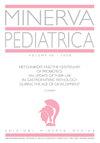聚乙二醇干扰素和利巴韦林在直接作用抗病毒药物时代消失了,但没有被遗忘。
IF 2.6
4区 医学
Q2 Medicine
引用次数: 0
摘要
背景聚乙二醇干扰素和利巴韦林(PEG-IFN+RBV)治疗慢性丙型肝炎(CHC)仍然是许多欧亚和欧洲国家儿童的唯一选择。我们的目的是评估宿主和病毒因素对基于IFN的治疗反应的影响,以优化目前无法获得直接作用抗病毒药物(DAA)的患者的治疗效果。方法对5~16岁的CHC患儿(10男7女)进行PEG-IFN+RBV治疗。终点为持续病毒学应答(SVR)。宿主和病毒因素被分为治疗前和治疗后对治疗反应的预测因素。结果1例患者获得SVR(64%),4例无反应(23%),2例复发(12%)。HCV RNA消除与以下变量之间存在显著关系:病毒基因型和早期病毒学应答(EVR)(分别为p<.037和p<.029)。在感染基因型3型HCV的患者中观察到更高的根除率(100%对基因型1或4型的65%),以及在第12周检测不到HCV RNA的患者中(88%对病毒血症的66%)。EVR与SVR相关(83%对0%,无应答者;p<.004)。IL28B rs12979860的C等位基因是EVR的预测因子(p<.043)。CC、CT和TT携带者的SVR率分别为:75%、67%和33%。结论在PEG-IFN+RBV开始前检测到有利的HCV和IL28B基因型,并且在EVR患者中继续使用它对于那些DAA仍然不可用的患者来说是非常重要的。本文章由计算机程序翻译,如有差异,请以英文原文为准。
Pegylated interferon and ribavirin gone but not forgotten in the era of direct-acting antivirals.
BACKGROUND
Therapy with pegylated interferon and ribavirin (PEG-IFN+RBV) for chronic hepatitis C (CHC) still remains the only option available for children in many Eurasian and European countries. Our aim was to evaluate the influence of host and viral factors on response to IFN-based therapy to optimize it for those in whom directly acting antivirals (DAA) are currently unavailable.
METHODS
Seventeen vertically infected, treatment naive children (10 male and 7 female) aged 5-16 years with CHC underwent a course of PEG-IFN+RBV. The end point was sustained virologic response (SVR). Host and virus factors were divided into pre- and ontreatment predictors of response to therapy.
RESULTS
Eleven patients obtained SVR (64%), 4 were nonresponders (23%), and 2 were relapsers (12%). Significant relationship was found between HCV RNA elimination and following variables: virus genotype and early virologic response (EVR) (p< .037, p< .029 respectively). Higher eradication rate was observed in patients infected with genotype 3 HCV (100% vs. 65% with genotype 1 or 4), and in those with undetectable HCV RNA by week 12 (88% vs. 66% with viremia). EVR was associated with SVR (83% vs. 0% in nonresponders; p< .004). C allele of IL28B rs12979860 was a predictor of EVR (p < .043). The SVR rates among CC, CT, and TT carriers were as follows: 75%, 67%, and 33%.
CONCLUSIONS
Detection of favourable HCV and IL28B genotype prior to commencement of PEG-IFN+RBV, and continuing it in patients with EVR is of major importance for those in whom DAA are still unavailable.
求助全文
通过发布文献求助,成功后即可免费获取论文全文。
去求助
来源期刊

Minerva pediatrica
PEDIATRICS-
CiteScore
2.70
自引率
3.80%
发文量
1
审稿时长
>12 weeks
期刊介绍:
Minerva Pediatrica publishes scientific papers on pediatrics, neonatology, adolescent medicine, child and adolescent psychiatry and pediatric surgery. Manuscripts may be submitted in the form of editorials, original articles, review articles, special articles, letters to the Editor and guidelines. The journal aims to provide its readers with papers of the highest quality and impact through a process of careful peer review and editorial work.
 求助内容:
求助内容: 应助结果提醒方式:
应助结果提醒方式:


